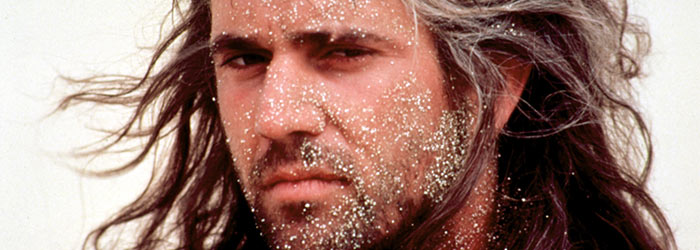
(Photo by Warner Bros/Getty Images. BEYOND THUNDERDOME.)
The latest: Beyond Thunderdome, the last movie in the original Mel Gibson-led trilogy, celebrates its 40th anniversary!
The original Mad Max, perennially set just a few years from right now, starred Mel Gibson as Max Rockatansky, an Australian officer patrolling a society in rapid decline from pollution and dwindling natural resources. Director George Miller keeps the exact details behind the dystopia in the margins, using the encroaching apocalypse as backdrop for high-flying action stunts and vehicular mayhem. Mad Max first released in 1979, deeply embedded in the Ozploitation era, when the country was pumping out grindhouse-allied movies like Wake in Fright, BMX Bandits, Dead End Drive-In, and The Cars That Ate Paris.
Miller and Gibson re-teamed for two sequels: 1981’s Mad Max 2 aka The Road Warrior, and Mad Max Beyond Thunderdome in 1985. Civilization has completely collapsed by the start of the first sequel, with Max turned taciturn survivalist as he prowls through barbaric communities that have sprouted across the wastelands. The leather scavenger chic of the sequels has influenced the look of just about ever desert post-apocalypse setting ever since. Though Miller considers the movies standalone stories, essentially as myths of a wanderer told over oil barrel camp fires, they easily form a trilogy with continuity across Max’s clothing, car, and obviously the actor portraying him.
While Beyond Thunderdome has its detractors for the relative sidelining of Max in favor a bunch of moppets and Tina Turner, it also had to follow up on Road Warrior, considered among the best action films ever made. The original trilogy:
![]() 89%
Mad Max
(1979)
89%
Mad Max
(1979)
![]() 93%
Mad Max 2: The Road Warrior
(1981)
93%
Mad Max 2: The Road Warrior
(1981)
![]() 80%
Mad Max Beyond Thunderdome
(1985)
80%
Mad Max Beyond Thunderdome
(1985)
2015’s Mad Max: Fury Road was in development for decades, which gave Miller and his collaborators ample time to forge lore, worldbuilding, and deep backstories for Max, warlord Immortan Joe, his rogue lieutenant Furiosa, and War Boy underling Nux. Tom Hardy takes on the Max mantle, with Charlize Theron as Furiosa. Immortan Joe is played by Hugh Keays-Byrne, who was also the villain Toecutter in the first movie.
To avoid contradictions while reinforcing the conceptual mythmaking of Max’s world, Fury Road is part of a separate timeline. The events of the original trilogy have still occurred, but details are changed wherever the new story dictates it. Miller was involved with a 2015 four-issue comic book series that reveals Immortan Joe’s rise to power, Nux’s upbringing, Furiosa’s motives for rebelling, and how Max got his Interceptor car back between Thunderdome and Fury Road. (The open-world Mad Max video game is its own continuity.)
The protracted development of Fury Road was a cakewalk compared to the actual filming, which included flooded sets, long sun-scorched days in Namibia, and feuding lead actors. (The nightmarish shoot is all documented in the book Blood, Sweat & Chrome by Kyle Buchanan.) The result: A groundbreaking assault on the senses and pure action cinema with six Oscar wins, plus nominations for Best Picture and Best Director.
With Furiosa: A Mad Max Saga, mastermind Miller is pulling on the the straightest, strongest thread between films, as the 2024 film is explicitly set 15 years before Fury Road, with Anya Taylor-Joy sliding in. The modern timeline:
![]() 97%
Mad Max: Fury Road
(2015)
97%
Mad Max: Fury Road
(2015)
![]() 90%
Furiosa: A Mad Max Saga
(2024)
90%
Furiosa: A Mad Max Saga
(2024)
Read on for an expanded list to Mad Max movies in order!